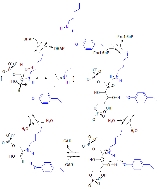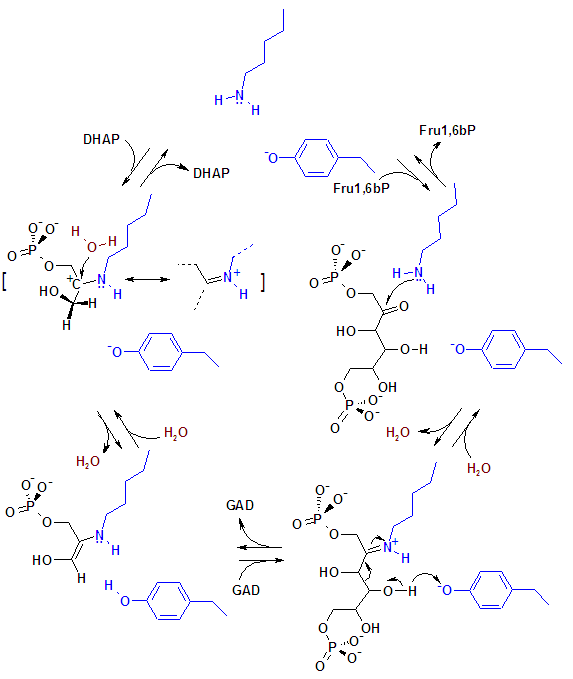
Aldolase
Encyclopedia
Aldolase A is an enzyme
that catalyses a reverse aldol reaction
: The substrate
, fructose 1,6-bisphosphate
(F-1,6-BP) is broken down into glyceraldehyde 3-phosphate
and dihydroxyacetone phosphate (DHAP
). This reaction
is a part of glycolysis
. Three aldolase isozymes (A, B, and C), encoded by three different genes, are differentially expressed during development. Aldolase A is found in the developing embryo and is produced in even greater amounts in adult muscle. Aldolase A expression is repressed in adult liver, kidney, and intestine and similar to aldolase C levels in brain and other nervous tissue. Aldolase A deficiency has been associated with myopathy and hemolytic anemia. Alternative splicing of this gene results in multiple transcript variants that encode the same protein.
The numbering of the carbon atoms indicates the fate of the carbons according to their position in fructose 6-phosphate.
residues involved in the reaction are lysine
and tyrosine
. The tyrosine acts as an efficient hydrogen acceptor while the lysine covalently binds and stabilizes the intermediates. Many bacteria
use two magnesium
ions in place of the lysine.
with PLD2
.
Enzyme
Enzymes are proteins that catalyze chemical reactions. In enzymatic reactions, the molecules at the beginning of the process, called substrates, are converted into different molecules, called products. Almost all chemical reactions in a biological cell need enzymes in order to occur at rates...
that catalyses a reverse aldol reaction
Aldol reaction
The aldol reaction is a powerful means of forming carbon–carbon bonds in organic chemistry.Discovered independently by Charles-Adolphe Wurtz and Alexander Porfyrevich Borodin in 1872, the reaction combines two carbonyl compounds to form a new β-hydroxy carbonyl compound...
: The substrate
Substrate (biochemistry)
In biochemistry, a substrate is a molecule upon which an enzyme acts. Enzymes catalyze chemical reactions involving the substrate. In the case of a single substrate, the substrate binds with the enzyme active site, and an enzyme-substrate complex is formed. The substrate is transformed into one or...
, fructose 1,6-bisphosphate
Fructose 1,6-bisphosphate
Fructose 1,6-bisphosphate is fructose sugar phosphorylated on carbons 1 and 6 . The β-D-form of this compound is very common in cells...
(F-1,6-BP) is broken down into glyceraldehyde 3-phosphate
Glyceraldehyde 3-phosphate
Glyceraldehyde 3-phosphate, also known as triose phosphate or 3-phosphoglyceraldehyde and abbreviated as G3P, GADP, GAP, TP, GALP or PGAL, is a chemical compound that occurs as an intermediate in several central metabolic pathways of all organisms...
and dihydroxyacetone phosphate (DHAP
Dhap
Dhap is a village development committee in Darchula District in the Mahakali Zone of western Nepal. At the time of the 1991 Nepal census it had a population of 4092 people living in 694 individual households.-External links:*...
). This reaction
Chemical reaction
A chemical reaction is a process that leads to the transformation of one set of chemical substances to another. Chemical reactions can be either spontaneous, requiring no input of energy, or non-spontaneous, typically following the input of some type of energy, such as heat, light or electricity...
is a part of glycolysis
Glycolysis
Glycolysis is the metabolic pathway that converts glucose C6H12O6, into pyruvate, CH3COCOO− + H+...
. Three aldolase isozymes (A, B, and C), encoded by three different genes, are differentially expressed during development. Aldolase A is found in the developing embryo and is produced in even greater amounts in adult muscle. Aldolase A expression is repressed in adult liver, kidney, and intestine and similar to aldolase C levels in brain and other nervous tissue. Aldolase A deficiency has been associated with myopathy and hemolytic anemia. Alternative splicing of this gene results in multiple transcript variants that encode the same protein.
The numbering of the carbon atoms indicates the fate of the carbons according to their position in fructose 6-phosphate.
Mechanism
In mammalian aldolase, the key catalytic amino acidAmino acid
Amino acids are molecules containing an amine group, a carboxylic acid group and a side-chain that varies between different amino acids. The key elements of an amino acid are carbon, hydrogen, oxygen, and nitrogen...
residues involved in the reaction are lysine
Lysine
Lysine is an α-amino acid with the chemical formula HO2CCH4NH2. It is an essential amino acid, which means that the human body cannot synthesize it. Its codons are AAA and AAG....
and tyrosine
Tyrosine
Tyrosine or 4-hydroxyphenylalanine, is one of the 22 amino acids that are used by cells to synthesize proteins. Its codons are UAC and UAU. It is a non-essential amino acid with a polar side group...
. The tyrosine acts as an efficient hydrogen acceptor while the lysine covalently binds and stabilizes the intermediates. Many bacteria
Bacteria
Bacteria are a large domain of prokaryotic microorganisms. Typically a few micrometres in length, bacteria have a wide range of shapes, ranging from spheres to rods and spirals...
use two magnesium
Magnesium
Magnesium is a chemical element with the symbol Mg, atomic number 12, and common oxidation number +2. It is an alkaline earth metal and the eighth most abundant element in the Earth's crust and ninth in the known universe as a whole...
ions in place of the lysine.
 |
Interactions
Aldolase A has been shown to interactProtein-protein interaction
Protein–protein interactions occur when two or more proteins bind together, often to carry out their biological function. Many of the most important molecular processes in the cell such as DNA replication are carried out by large molecular machines that are built from a large number of protein...
with PLD2
PLD2
Phospholipase D2 is an enzyme that in humans is encoded by the PLD2 gene.-Interactions:PLD2 has been shown to interact with BIN1, Amphiphysin, Aldolase A, PLCG1, ARF1, Src, PRKCD, Glyceraldehyde 3-phosphate dehydrogenase ,Caveolin 1,and Wiskott-Aldrich syndrome protein.-Inhibitors:* N--2-naphthamide:...
.
External links
- http://pdbdev.sdsc.edu:48346/pdb/molecules/pdb50_5.html

